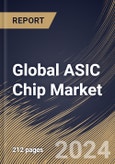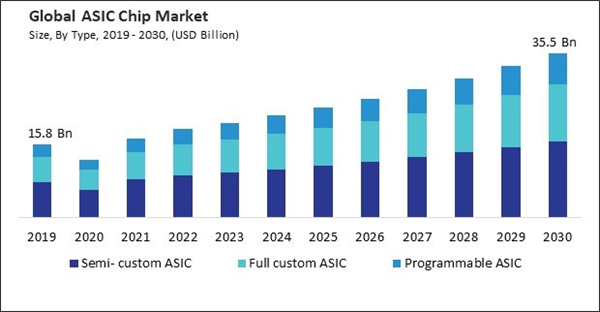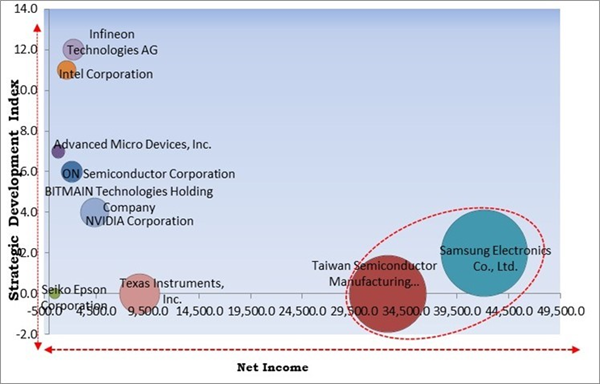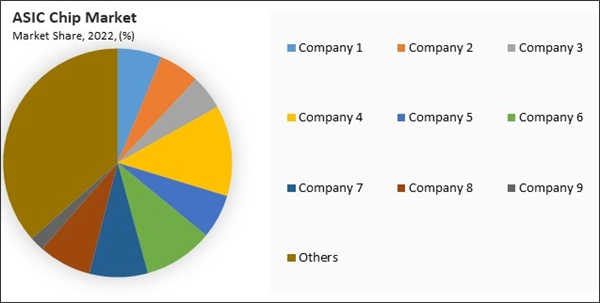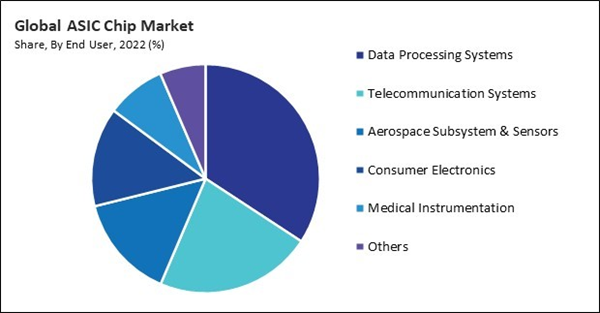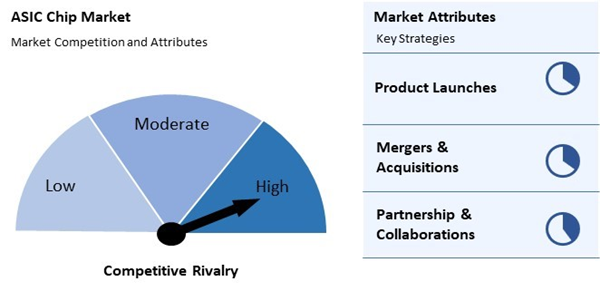The Global ASIC Chip Market size is expected to reach $35.5 billion by 2030, rising at a market growth of 8.2% CAGR during the forecast period.
The ever-growing demand for smartphones and tablets is a key driver for the consumer electronics segment. Thus, the consumer electronics segment acquired $2,683.1 million in 2022. ASICs are used in these devices for various functions, including signal processing, graphics rendering, and power management, contributing to enhanced performance and efficiency.
The major strategies followed by the market participants are Partnerships & Collaborations as the key developmental strategy to keep pace with the changing demands of end users. For instance, In Feb 2024, Intel Corporation signed a collaboration with Wipro to accelerate the development of advanced and innovative chip designs. Additionally, In, Jul 2022, Intel Corporation came into partnership with MediaTek to manufacture chips, leveraging the advanced process technologies offered by Intel Foundry Services (IFS).
Additionally, ASICs can be designed to accelerate the computations commonly involved in AI and ML tasks, such as matrix multiplications and convolutions. This targeted optimization results in significantly higher performance than general-purpose processors that may not be as well-suited for these specific workloads. Therefore, these factors can assist in the growth of the market.
The leading players in the market are competing with diverse innovative offerings to remain competitive in the market. The above illustration shows the percentage of revenue shared by some of the leading companies in the market. The leading players of the market are adopting various strategies in order to cater demand coming from the different industries. The key developmental strategies in the market are Partnerships & Collaborations.
The ASIC chip market is fiercely competitive across multiple sectors, including cryptocurrency mining, artificial intelligence, networking, and emerging technologies. Companies like BITMAIN Technologies Holding Company and Taiwan Semiconductor Manufacturing Company Limited vie for dominance in cryptocurrency mining, while tech giants such as NVIDIA, Intel, and Samsung Electronics Co., Ltd. compete vigorously in AI, networking, and telecommunications.
The ever-growing demand for smartphones and tablets is a key driver for the consumer electronics segment. Thus, the consumer electronics segment acquired $2,683.1 million in 2022. ASICs are used in these devices for various functions, including signal processing, graphics rendering, and power management, contributing to enhanced performance and efficiency.
The major strategies followed by the market participants are Partnerships & Collaborations as the key developmental strategy to keep pace with the changing demands of end users. For instance, In Feb 2024, Intel Corporation signed a collaboration with Wipro to accelerate the development of advanced and innovative chip designs. Additionally, In, Jul 2022, Intel Corporation came into partnership with MediaTek to manufacture chips, leveraging the advanced process technologies offered by Intel Foundry Services (IFS).
Cardinal Matrix - Market Competition Analysis
Based on the Analysis presented in the Cardinal Matrix; Samsung Electronics Co., Ltd. and Taiwan Semiconductor Manufacturing Company Limited are the forerunners in the ASIC Chip Market. In Mar 2021, Samsung Electronics Co., Ltd. and Marvell Technology, Inc to accelerate the advancement of high-impact 5G solutions that provide a competitive advantage to their operators. Companies such as Texas Instruments, Inc., NVIDIA Corporation, and Infineon Technologies AG are some of the key innovators in Market.Market Growth Factors
ASICs are known for their high performance and efficiency in specific applications. As industries demand faster and more specialized processing capabilities, ASICs are preferred to meet these performance requirements. Thus, these factors can assist in the growth of the market.Additionally, ASICs can be designed to accelerate the computations commonly involved in AI and ML tasks, such as matrix multiplications and convolutions. This targeted optimization results in significantly higher performance than general-purpose processors that may not be as well-suited for these specific workloads. Therefore, these factors can assist in the growth of the market.
Market Restraining Factors
The substantial upfront costs associated with ASIC (application-specific integrated circuit) design and development can be a significant barrier for smaller companies or projects with limited budgets. Thus, owing to these factors, there will be reduced demand for ASIC chips in the coming years.The leading players in the market are competing with diverse innovative offerings to remain competitive in the market. The above illustration shows the percentage of revenue shared by some of the leading companies in the market. The leading players of the market are adopting various strategies in order to cater demand coming from the different industries. The key developmental strategies in the market are Partnerships & Collaborations.
By End User Analysis
On the basis of end user, the market is divided into data processing systems, consumer electronics, telecommunication systems, aerospace subsystem & sensors, medical instrumentation, and others. The data processing systems segment recorded 34.2% revenue share in the market in 2022.By Type Analysis
Based on type, the market is segmented into semi-custom ASIC, programmable ASIC, and full custom ASIC. In 2022, the programmable ASIC segment garnered 18% revenue share in the market. Programmable logic devices, especially FPGAs, provide great flexibility and customization.By Regional Analysis
By region, the market is segmented into North America, Europe, Asia Pacific, and LAMEA. In 2022, the Asia Pacific segment acquired 39% revenue share in the market. The Asia Pacific region, particularly countries like China, Japan, South Korea, and Taiwan, has been at the forefront of technology adoption and innovation.Market Competition and Attributes
The ASIC chip market is fiercely competitive across multiple sectors, including cryptocurrency mining, artificial intelligence, networking, and emerging technologies. Companies like BITMAIN Technologies Holding Company and Taiwan Semiconductor Manufacturing Company Limited vie for dominance in cryptocurrency mining, while tech giants such as NVIDIA, Intel, and Samsung Electronics Co., Ltd. compete vigorously in AI, networking, and telecommunications.
Recent Strategies Deployed in the Market
- Feb-2024: Intel Corporation signed a collaboration with Wipro, a multinational corporation specializing in information technology services, consulting, and business process outsourcing. Through this collaboration, both companies would accelerate the development of advanced and innovative chip designs. Moreover, the collaboration seeks to meet the increasing need for AI chip production, as companies compete to introduce products equipped with generative AI capabilities.
- Jun-2023: Advanced Micro Devices, Inc. launched AMD Versal™ Premium VP1902, a high-performance system-on-chip (SoC) designed for advanced computing and acceleration applications. The VP1902 adaptive SoC is a chipset-based solution that accelerates semiconductor design verification with double the capacity of its predecessor, enabling faster innovation and validation of ASICs and SoCs for rapid market deployment of next-gen technologies.
- Jul-2022: Intel Corporation came into partnership with MediaTek, a semiconductor company renowned for its innovative system-on-chip solutions for various electronic devices. Through this partnership, both companies would aim to manufacture chips, leveraging the advanced process technologies offered by Intel Foundry Services (IFS).
- Feb-2022: Advanced Micro Devices, Inc. took over Xilinx, a leading provider of adaptive and intelligent computing solutions, specializing in field-programmable gate arrays (FPGAs) and programmable logic devices. Through this acquisition, AMD and Xilinx would expedite their capacity to shape a new era of computing, offering an extensive range of adaptive computing platforms to drive diverse intelligent applications effectively.
- Nov-2021: ON Semiconductor Corporation and GT Advanced Technologies, a manufacturer of advanced materials and equipment for the solar and semiconductor industries. Through this acquisition, onsemi would be able to deliver comprehensive power solutions spanning from SiC crystal growth to fully integrated intelligent power modules.
List of Key Companies Profiled
- Advanced Micro Devices, Inc.
- Samsung Electronics Co., Ltd. (Samsung Group)
- ON Semiconductor Corporation
- Taiwan Semiconductor Manufacturing Company Limited
- NVIDIA Corporation
- Intel Corporation
- Infineon Technologies AG
- Texas Instruments, Inc.
- Seiko Epson Corporation
- BITMAIN Technologies Holding Company
Market Report Segmentation
By Type- Semi- custom ASIC
- Full custom ASIC
- Programmable ASIC
- Data Processing Systems
- Telecommunication Systems
- Aerospace Subsystem & Sensors
- Consumer Electronics
- Medical Instrumentation
- Others
- North America
- US
- Canada
- Mexico
- Rest of North America
- Europe
- Germany
- UK
- France
- Russia
- Spain
- Italy
- Rest of Europe
- Asia Pacific
- China
- Japan
- India
- South Korea
- Singapore
- Malaysia
- Rest of Asia Pacific
- LAMEA
- Brazil
- Argentina
- UAE
- Saudi Arabia
- South Africa
- Nigeria
- Rest of LAMEA
Table of Contents
Chapter 1. Market Scope & Methodology
Chapter 2. Market at a Glance
Chapter 3. Market Overview
Chapter 4. Competition Analysis - Global
Chapter 5. Global ASIC Chip Market by Type
Chapter 6. Global ASIC Chip Market by End User
Chapter 7. Global ASIC Chip Market by Region
Chapter 8. Company Profiles
Companies Mentioned
- Advanced Micro Devices, Inc.
- Samsung Electronics Co., Ltd. (Samsung Group)
- ON Semiconductor Corporation
- Taiwan Semiconductor Manufacturing Company Limited
- NVIDIA Corporation
- Intel Corporation
- Infineon Technologies AG
- Texas Instruments, Inc.
- Seiko Epson Corporation
- BITMAIN Technologies Holding Company
Methodology

LOADING...


